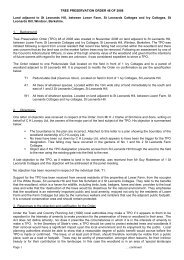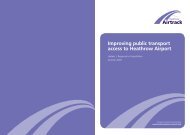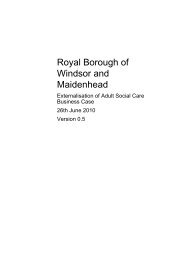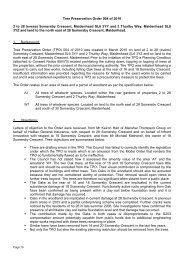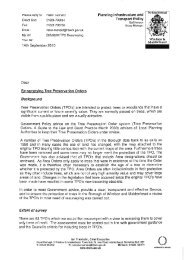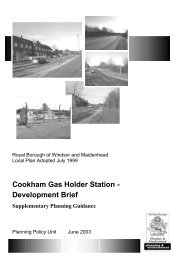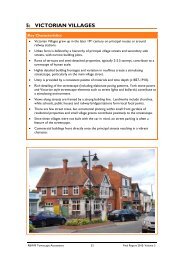Maidenhead Riverside Conservation Area Appraisal - The Royal ...
Maidenhead Riverside Conservation Area Appraisal - The Royal ...
Maidenhead Riverside Conservation Area Appraisal - The Royal ...
- No tags were found...
Create successful ePaper yourself
Turn your PDF publications into a flip-book with our unique Google optimized e-Paper software.
62<br />
<strong>Maidenhead</strong> <strong>Riverside</strong> <strong>Conservation</strong> <strong>Area</strong> <strong>Appraisal</strong><br />
9<br />
Opportunities for Enhancement and Change<br />
Condition<br />
9.1 <strong>The</strong> majority of properties within the <strong>Conservation</strong> <strong>Area</strong> are well maintained and set in attractive grounds.<br />
<strong>The</strong>refore, there is little need for action to be taken to repair individual buildings, although there are some<br />
exceptions to be found along Ray Park Avenue.<br />
9.2 <strong>The</strong> refurbishment and general works undertaken to Boulters restaurant have allowed what was a<br />
previously run down vacant building in a prominent and popular location to be brought back into use.<br />
9.3 <strong>The</strong> open spaces are well taken care of, as are the public open spaces.<br />
Sensitivity to Change<br />
9.4 <strong>Maidenhead</strong> riverside is considered a desirable suburban location and as such, will always be subject<br />
to pressures of change. <strong>The</strong> character of the area would be impacted upon negatively through the further<br />
erosion of traditional plots and the insertion of more large scale flatted developments. <strong>The</strong> retention of the<br />
remaining 19 th century development is fundamental to the <strong>Conservation</strong> <strong>Area</strong>.<br />
9.5 Flood-proofing measures and flood resilient design are likely to be the biggest issues in these areas in<br />
terms of future development. How buildings are designed to take account of both floodplain policy and also the<br />
surrounding <strong>Conservation</strong> <strong>Area</strong> will need careful consideration by developers. In particular, the incorporation<br />
of flood voids, raised floor levels and the effect this will have on ridge height, windows and doors will need to<br />
be accounted for. Please note that the River Thames is classified as a “Main River”. As such, under the terms<br />
of the Water Resources Act 1991, and the Thames Land Drainage Byelaws 1981, the prior consent of the<br />
Environment Agency is required for any proposed works or structures, in, under, over or within 8 metres of the<br />
top of the bank both watercourses.<br />
9.6 <strong>The</strong> erosion of architectural details of properties would have a significant impact on the <strong>Conservation</strong><br />
<strong>Area</strong>. Alterations such as the replacement of traditional timber windows with UPVC double glazed units or the<br />
modification of a roof covering are aspects which can fall outside general planning control but could have a<br />
huge impact on many properties in the area. <strong>The</strong> proposed Article 4(2) direction could help to address this<br />
issue (see Additional Planning Controls).<br />
9.7 <strong>The</strong> forthcoming Crossrail development will see the overhead electrification of the Great Western line<br />
between Paddington and <strong>Maidenhead</strong> and this will require the Brunel Bridge to undergo some changes in order<br />
to accommodate the overhead line equipment. <strong>The</strong> proposed overhead masts will have a significant landscape<br />
impact and affect important views along the river and they will affect the appearance of the listed railway bridge<br />
and the setting of the adjacent Grade I listed road bridge. Furthermore, the increased amount of high speed<br />
train traffic may have an impact on the <strong>Conservation</strong> <strong>Area</strong>.<br />
9.8 <strong>The</strong>re are proposals to alter the traffic control system at the <strong>Maidenhead</strong> Bridge roundabout. <strong>The</strong> design<br />
of this will need to take account of the sensitive location and seek to minimise the impact of any signage for<br />
example.<br />
9.9 <strong>The</strong> character of the area is also sensitive to change through any loss of green spaces or significant<br />
planting.<br />
Negative <strong>Area</strong>s<br />
9.10 Heavy volumes of traffic along the A4 exacerbate noise pollution, congestion and speed, which can all<br />
contribute to the deterioration of the Grade I listed bridge. <strong>The</strong> A4094 can be equally as congested during peak<br />
hours and creates a negative feature within the <strong>Conservation</strong> <strong>Area</strong>. <strong>Maidenhead</strong> Bridge is classified as a<br />
congestion hot-spot in the draft 2009 RBWM Local Transport Plan: Issues and Options Paper.<br />
9.11 <strong>The</strong> petrol station, although serving an important local function, does have a negative impact due to the<br />
large expanse of tarmac immediately surrounding the garage. <strong>The</strong> visually unattractive area of open hard<br />
standing is at odds with the soft, green landscaping of the <strong>Conservation</strong> <strong>Area</strong> generally. Furthermore, the<br />
building itself is utilitarian in nature and constructed from inappropriate materials that do not compliment this<br />
part of the <strong>Conservation</strong> <strong>Area</strong>.








